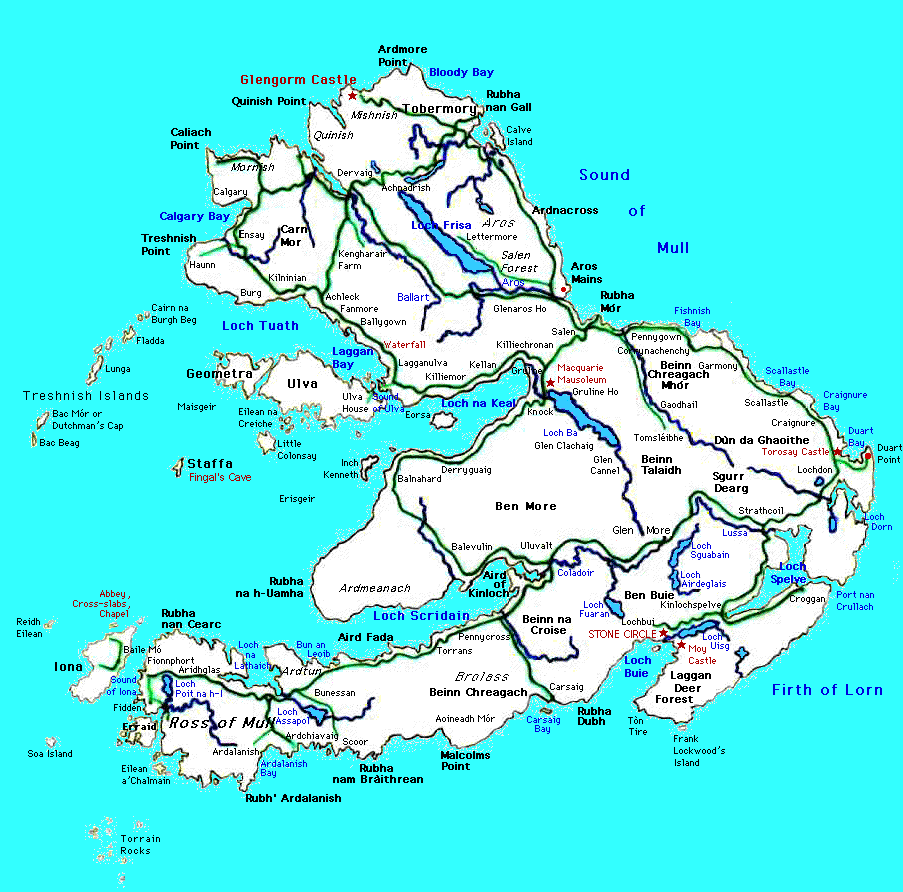A GENEALOGY STUDY OF LACHLAN MCNEILL FROM MULL TO TIREE
"Calgary is located on the north west of Mull about 5 miles beyond Dervaig and 12 miles from the island’s capital Tobermory. It is framed by low hills, partly wooded and is the location of a shimmering white shell sand beach and craggy headlands – home to a rich variety of birdlife and the haunting ruins of stone forts and abandoned villages.
The name Calgary comes from the Gaelic, Cala Ghearraidh, meaning Beach of the Meadow.
Calgary – A brief history
The main settlement was once at Inivea, above Calgary Pier, which became uninhabited in the early 1800’s during the Highland Clearances. Unfortunately the unscrupulous laird thought he could earn more money by grazing sheep on the land. The settlement of today is scattered around the vicinity of the Calgary Farmhouse and Hotel."
Source: http://www.isle-of-mull.net/attractions/scenic-attractions/calgary-bay/
Lachlan married Mary McLean of Mull. It is thought that she was born in Inieva circa 1798 or 1799.
 source for map: https://www.bing.com/images/search?q=map+of+mull&view=detailv2&&id=F5A298C24D09A8D1900884A9BB05D88340B46478&selectedIndex=0&ccid=HMVsEBuQ&simid=607998092550472376&thid=OIP.M1cc56c101b90c283ae9c8707f99a00edo0&ajaxhist=0
source for map: https://www.bing.com/images/search?q=map+of+mull&view=detailv2&&id=F5A298C24D09A8D1900884A9BB05D88340B46478&selectedIndex=0&ccid=HMVsEBuQ&simid=607998092550472376&thid=OIP.M1cc56c101b90c283ae9c8707f99a00edo0&ajaxhist=0
Lachlan and Mary were married on October 15, 1822, at Kilninian and Kilmore, Mull. Their first five (5) children were also born on Mull (Janet-1823, Flora-1825, Neil-1829, Mary-1831, Catherine-1834). Pure speculation but there may have been another child between Flora and Neil due to the 4 year gap between their births.
At the ages of 40 and 37, with children ages 12, 10, 6, 4, and 1, the family moved from Mull to Tyree, another inner Hebridean island. They possibly went from one island to the other using a ferry between Mull and Coll and then some form of private boat hired to get them from Coll to Mull.
Here's some information I've come across about getting to Tiree in the late 18th and early 19th centuries:
At the ages of 40 and 37, with children ages 12, 10, 6, 4, and 1, the family moved from Mull to Tyree, another inner Hebridean island. They possibly went from one island to the other using a ferry between Mull and Coll and then some form of private boat hired to get them from Coll to Mull.
Here's some information I've come across about getting to Tiree in the late 18th and early 19th centuries:
"Ferries
In 1792 Scarinish was recoded as having a harbour in need of considerable improvements. At that time there was a regular ferry boat sailing between Coll and Tiree, and between Coll and Mull, "but there is no stated ferry between Tiree and Mull, although there is a great need."
Even by 1845 it was reported that there has been no ferry to Tiree for some years. “Our means of communication are accordingly extremely irregular and uncertain, depending on any casual conveyance that may occur."
Source: http://www.isleoftiree.com/about-tiree/the-sea/
The 6th child born to Lachlan and Mary was Alexander who was born January 5, 1836, on the Island of Tyree, so Lachlan and Mary were likely on Tyree by 1835. Daughter Catherine was born circa 1834 on Mull so this narrows the movement from Mull to Tyree to the period of 1834 to 1835.
A cottar is a farm worker who, in return for a cottage, gives labor at a fixed rate when required.
[From Middle English coter, from Old French coter, cotier; akin to Medieval Latin cotarius : Medieval Latin cota, cottage (of Germanic origin and akin to Old English cot, cottage) + Latin -arius, adj. and n. suff.]
Source: American Heritage® Dictionary of the English Language, Fifth Edition. Copyright © 2011 by Houghton Mifflin Harcourt Publishing Company. Published by Houghton Mifflin Harcourt Publishing Company. All rights reserved.
If one tries to imagine the type of dwelling in which they lived one could refer to various sources. I've turned to http://www.isleoftiree.com/about-tiree/the-land/ :
"The traditional house is built from partly dressed stones laid without mortar in a double wall. Between the two skins is a layer of sand. Walls are commonly six feet thick with deep inset windows and one doorway. The roof trusses are set onto the inside wall and water runs off the roof and down between the two layers of stone.
The usual material for thatching is muran (grass) which grows on the beach dunes. The muran is laid on loose, and new thatch applied over the old every two years. Traditionally it was held down with an elaborate design of rope held down with stone weights. Chicken wire or fishing nets are now used instead.
Grass or flowers, and occasionally even rhubarb, grew on the tobhta(the wide wall head) and in the summer the dog would lie there. If the dog was absent sheep, and occasionally cattle, would climb up to graze."

More about Lachlan, Mary and their family in future blogs.
This is fascinating. Excellent context and colour. Imagine, rhubarb on the wall head, with a dog lying beside it, soaking up the sun and guarding the house.
ReplyDeleteYes, I found that part of the description particularly appealing! But that's my rose-coloured glasses.
Delete